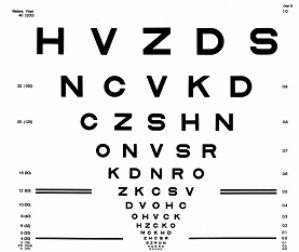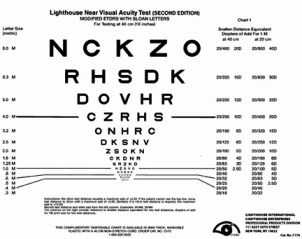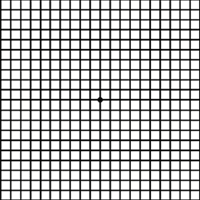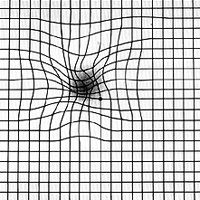The Low Vision Examination
This content is also available in:
Español (Spanish)
What Is a Low Vision Examination?
Suppose you, a family member, or a friend has one or more eye disorders, such as glaucoma, cataracts, macular degeneration, or diabetic retinopathy, it’s important to have a comprehensive low-vision examination – performed by an ophthalmologist or optometrist who specializes in low vision – to determine whether special low vision optical devices, better lighting, large print reading materials, or other types of training, such as vision rehabilitation services, can help you, your family member, or your friend with low vision to use his or her functional vision more effectively.
An important part of the examination is for you, your doctor, and his or her social worker to discuss how you are adapting emotionally to your vision loss, whether you are motivated to learn a different way of doing things, and if you have family and friends to support you.
A comprehensive low vision examination is not rushed and is very thorough, taking 2-3 times longer than a regular eye examination.
A Functional Eye Exam
The low-vision eye care specialist is trained to conduct a functional eye examination that focuses directly on how a person’s particular vision impairment affects his or her day-to-day living.
Some examples of functional vision problems can include:
- Difficulty seeing the height of the gas flame when cooking
- Problems crossing streets or seeing traffic
- Difficulty seeing information on a computer screen
- Problems threading a needle or making clothing repairs
- Difficulty reading, such as using the telephone book or looking through magazines, even with regular eyeglasses.
Preparing for the Low Vision Examination
Before arriving for the low vision examination, it’s helpful to make a list of questions for your doctor. Here are some suggestions:
- What is the name of my eye disease or disorder?
- What is the cause of my vision loss?
- Is my condition stable, or can I lose more sight?
- Is there any treatment for my eye condition?
- What is my visual acuity?
- Do I have a loss of side (or peripheral) vision?
- Will regular eyeglasses help me?
- How can I protect my remaining vision?
- Do I need any special medications?
- Do I qualify as legally blind? If so, what does legally blind actually mean?
- Am I entitled to any special services or benefits?
- What resources and rehabilitation services are available to help me?
Also, it is helpful to make a list of activities that you want and needs to do, such as sewing, playing cards, watching ball games, or going to the theater, and to list the types of reading materials you want – and need – to access. This information can help focus your discussions with your low-vision doctor and his or her professional staff.
A Helpful Checklist
Here is a checklist to help you prepare for your low vision exam, brought to you by the San Antonio Lighthouse for the Blind:
- Bring any glasses, adaptive aids, and magnifiers that you are currently using to show the specialist. What do you like or dislike about each item?
- Remember that this examination may take longer than one with your optometrist or ophthalmologist. If you have diabetes, be sure to bring a snack with you.
- Bring all forms of insurance with you. Keep in mind that many devices or aids will not be covered by your insurance plan. If you have questions about whether the exam will be covered, ask the low-vision clinic prior to your appointment.
- Write a list of areas that you currently have trouble with in relation to your vision. What are your goals and expectations in these areas?
- Does sunlight bother you? Can you read standard print? Can you travel independently?
Remember, the more information you can provide, the better the staff will be able to assist you.
Components of the Low Vision Examination
A comprehensive low-vision examination always includes the following components:
A Health and Medication History
- Your overall health and that of your immediate family
- The medications you are taking (prescription and over-the-counter)
- Questions about high blood pressure (hypertension), diabetes, smoking, and sun exposure.
A Vision History
- How well you can see at present, including any recent changes in your vision
- Eye diseases that you or your family members have had
- Previous eye treatments, surgeries, or injuries
- The date of your last eye examination.
A Low Vision History
- When your vision problems began
- Any prior vision rehabilitation services you’ve had
- Questions about activities that are becoming difficult for you, such as reading, meal preparation, or walking indoors and outdoors.
An Eye Health Evaluation
- An examination of the external parts of your eyes, including the shape of your pupils and how they react to light; your eyelids and surrounding tissues; your eye muscles, tear ducts, and cornea
- A dilated internal examination. Special eye drops will dilate, or open, your pupil, which allows the doctor to look through your enlarged pupil opening and observe the inner parts of your eye, such as the retina and optic nerve.
- A tonometry test of the fluid pressure, called intraocular pressure (IOP), within your eyes.
- Your doctor may also perform an optical coherence tomography (OCT) test, which produces a high-resolution cross-sectional image of the retina. This test can also be used to provide a clearer picture of the layers of your retina.
A Low Vision Refraction, or Visual Acuity Testing
- Your doctor will use specialized low-vision eye charts that are different from the eye charts used in a regular eye examination.
- These special low-vision eye charts contain different-sized letters and numbers that can help determine the sharpness or clarity of both your near (reading) and distance vision.
Here are some examples of specialized low-vision eye charts:

The Bailey-Lovie Acuity Chart

The Early Treatment of Diabetic Retinopathy
Study (ETDRS) Chart

The MN Read Low Vision Acuity Chart

The Lighthouse Near Visual Acuity Chart
The Amsler Grid Test
Your doctor may also use the Amsler Grid test to check for the presence of macular degeneration or diabetic retinopathy.
- The Amsler Grid test looks like a piece of white graph paper with darker horizontal and vertical lines that form a square grid.
- Wavy, distorted, missing, or broken lines, or holes or black spots in the grid can indicate eye problems that require monitoring:

The Amsler Grid as seen with regular vision

The Amsler Grid as seen with macular degeneration
Visual Field Testing
- To determine how many sides (or peripheral) vision you have and how much surrounding area you can see
- The low vision specialist will likely perform a very precise visual field measurement, using a computerized visual field analyzer, such as the Humphrey Visual Field Analyzer, or a non-computerized visual field test, such as the tangent screen or the Goldmann Perimeter Exam:

The Humphrey Field Analyzer

The Goldmann Perimeter Exam
Specialized Tests
Your doctor may also administer a number of specialized tests to evaluate:
- depth perception
- color vision
- contrast sensitivity
The doctor and his or her staff may also introduce, and measure your response to, different lighting conditions and different colored sun lenses and filters that can control glare.
Questions Your Doctor Will Ask
Since much of the examination will focus on what your functional needs are in your day-to-day life, you will be asked a wide range of easy-to-answer questions. Some of these questions will be about your habits or activities in reading and near vision activities, such as the following:
- What size print can you now read?
- Do you want to continue reading newspapers?
- Can you read your bills?
- Do you “spot read” more than you read novels or books?
- Have you had low-vision devices, such as magnifiers, in the past? If so, do you still use them? If not, why not?
In terms of everyday activities, questions may include:
- Can you see to use a checkbook?
- Can you read your watch?
- Can you do regular household tasks, such as cleaning and laundry?
- Can you care for your personal grooming needs, such as shaving or applying makeup?
- Can you see to use a computer?
- Are you able to continue your hobbies?
- Can you watch television?
- Can you travel independently and safely?
- Are you still driving? If so, do you still feel safe driving?
- Does bright sunlight bother you?
- Has your vision problem affected your employment or educational studies?
- If you have diabetes, can you see to fill your insulin syringes?
- Can you differentiate among your medications?
All of these questions are designed to gather information about your day-to-day functional needs and explore possible options for addressing those needs.
Vision Rehabilitation Services
Certified Low Vision Therapists (CLVTs), Vision Rehabilitation Therapists (CVRTs), Occupational Therapists (OTs), and Orientation and Mobility Specialists (COMS) often work in close partnership with the optometrist or ophthalmologist and can provide training in how to use low-vision optical, non-optical, or electronic magnifying devices in practical, everyday situations.